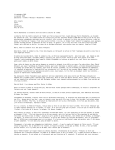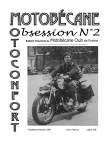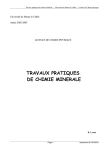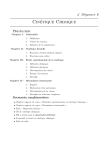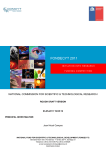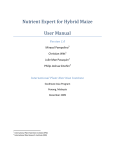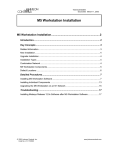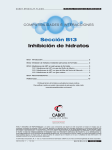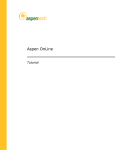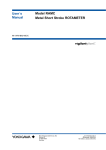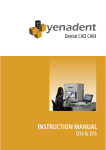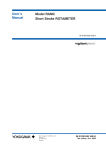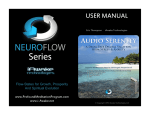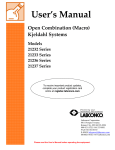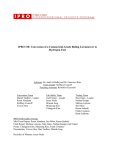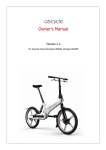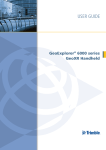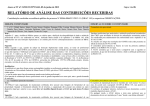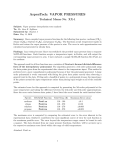Download Progress Report from IPRO 304
Transcript
Mid-Term Progress Report IPRO 304 Fall 2004 22nd Oct 2004 IPRO 304 Fall 204 – Mid-Term Progress Report Advisor: Professor Said Al-Hallaj Team Leader: Siddha Pimputkar 1. Executive Summary Since the project plan that was created on 10th Sep 2004 the objectives have been revised and the organization of the team has been improved. The following report will provide an insight on what has been accomplished so far and what the team aims to finish by the end of the semester. Looking back to the last couple of weeks various accomplishments have been made. Initially the team projected to have an extended test drive with the wheel chair to test the designed charging circuit so the batteries could be charged during driving using the fuel cell. Sadly two attempted drives failed partly due to design flaws and partly due to difficulties starting the fuel cell. Much was learned from these failed drives and currently a new improved charging circuit for the batteries is being built. The ultimate goal of this project is to perform a 100 mile drive with the wheel chair using this charging circuit to charge the batteries during operation of the wheel chair. As the difficulties in designing a charging circuit were larger than anticipated at the being of the semester this team will only provide a simulation and a theoretical design of a hybrid circuit for this particular system partially using the charging circuit that is being designed right now. The projected timeframe for the 100 mile drive is during the weeks of the 15th and 22nd of November. As the outdoor temperatures at this time of the year are rather cold various team members are looking into the feasibility of a test drive at this time of the year. If either the fuel cell or the batteries will not be able to perform under the given conditions it might become necessary to perform the 100 mile drive in an indoor facility. Next to the hybridization circuit research is also being done on the lithium-ion batteries. These batteries have been designed by the previous IPRO to fulfill the power requirements of the wheel chair. The lithium-ion batteries consist of 24 lithium-ion cells (4 in series, 6 in parallel), safety circuits to prevent over usage of the cells and a passive cooling system. Research is being done to improve the passive cooling system. Currently the passive cooling system consists of an expensive aluminum foam form and a phase change material, in our case it is paraffin wax. To decrease the cost and weight of the batteries the aluminum foam is being replaced with a carbon block that is rather light. Thermal testing is being performed on various types of carbon blocks to determine their feasibility and the optimal solution. -1- Mid-Term Progress Report IPRO 304 Fall 2004 22nd Oct 2004 In order to make this system transportable it needs to be stored on a trailer. The trailer from the previous IPRO was replaced by a new trailer that is considerably more stable and flexible when it comes to arranging and safely mounting the components. Further next to redesigning the trailer and the required attachment system to the wheelchair a new seat post was designed. Previously the seat was rather unstable and uncomfortable when sitting on it as it wobbled in all directions. This issue has now been solved. Apart from the electrical and mechanical engineering challenges to this project various achievements have been made concerning safety issues while using hydrogen and the design of a hydrogen production plant. A complete analysis has been performed on the safely use of hydrogen for this project and is available under the following URL: http://www.iit.edu/~ipro304cs4/safety.html. The design of a hydrogen production plant has made some significant progress. Currently two hydrogen production plants are being created as a model. One plant uses natural gas to create hydrogen, the other uses a sulfur/iodine thermochemical cycle powered by nuclear energy. Both designs are making progress and the results so far look promising. From a managing point of view the IPRO team had to slightly reorganize the teams. As is apparent in the more detailed descriptions of each team’s objectives and accomplishments provided later in this report the Fuel Cell Team which was created to design a charging circuit was dismantled and merged into the Hybridization Team which was concerned with designing a hybrid circuit. This was done partly because the Fuel Cell Team lacked the detailed required knowledge to create such a circuit. A new team – the Knowledge Team – was created in order to collect the data from the last IPRO and tests that have been performed on the fuel cell and batteries. Further their objective is to organize the data created in this IPRO with the data from the past to provide the next IPRO team a complete package on which they can easily build upon. As of right now there are 6 active teams: the Hybridization Team, the Battery Team, the Vehicle Design Team, the Knowledge Team, the Business Team and the Website Team. Each team will present a summary of their progress in the last 6 sections of this report. To provide an interface with the industry and other students / faculty members a website has been created to show the progress of the project and provide more detailed information. The site can be found under: http://www.iit.edu/~ipro304cs4/ . -2- Mid-Term Progress Report IPRO 304 Fall 2004 22nd Oct 2004 2. Timeline The following table provides a summary of the planed future tasks for this project until the semester end. Week of Planed Tasks Work on designing theoretical hybrid circuit Work on charging circuit Work on hydrogen production facilities / cost analysis Continue research / testing of batteries Work on vehicle design Collect data from past / current tests Determine if 100 mile drive possible due to cold weather Work on designing theoretical hybrid circuit Work on charging circuit Work on hydrogen production facilities / cost analysis Continue research / testing of batteries Work on vehicle design Collect data from past / current tests Finished: Design of vehicle Finished: Charging circuit Organize 100 mile drive Work on designing theoretical hybrid circuit Work on hydrogen production facilities / cost analysis Continue research on batteries Collect / Organize data from past / current tests Nov 15 100 mile Drive (End of week / Beginning next week) Work on designing theoretical hybrid circuit Work on hydrogen production facilities / cost analysis Continue research on batteries Organize data collected from past / current tests Nov 22 Finished: Theoretical hybrid circuit including simulation Finished: Research on batteries Finished: Creation of a “knowledge” database Finished: Hydrogen production facilities / cost analysis Backup week for 100 mile Drive Create exhibit poster and abstract for this project Nov 29 Prepare for presentation on 3rd Dec Write up final repot Website updated and finished Oct 25 Nov 1 Nov 8 -3- Mid-Term Progress Report IPRO 304 Fall 2004 22nd Oct 2004 3. Fuel Cell Team 3.1 Team Members Before the Fuel Cell Team was dismantled the team was comprised of the following members: Chrissy Lefief (Group Leader) Matt Moy Olatunde Omolaoye 3.2 Summary Although the Fuel Cell Team no longer exists, it is important for documentation purposes to acknowledge that this sub-group was created at the onset of the current IPRO. At the beginning of the semester, the Fuel Cell Team had three objectives: 1) Create a process flow sheet diagram concerning the reaction that occurs within the fuel cell, including material and energy balances and hydrogen consumption calculations based on the efficiency of the Independence 500 fuel cell 2) Design a DC/DC converter and construct it, so that the cart’s motor could run solely off the fuel cell 3) Design and create a circuit for charging the batteries from the fuel cell Upon completion of the first objective, it was discovered that the members of the Fuel Cell Team did not have the necessary electrical engineering knowledge in order to complete the remaining objectives. It was also discovered that, in order for the Hybridization Team to complete their objectives, data would need to be collected and many tests performed on the fuel cell. Although it would have been possible for the Hybridization Team to explain to the Fuel Cell Team what data they wanted and what tests run, it made more sense to have the Hybridization Team perform their own tests and collect the data. At this point, it was decided that there was no need for the Fuel Cell Team: the team was dismantled and the members were reassigned. -4- Mid-Term Progress Report IPRO 304 Fall 2004 22nd Oct 2004 4. Hybridization Team 4.1 Team Members The Hybridization Team started off with a group of three people. After the Fuel Cell Team was dismantled and it become clear that this team needed a considerable increase in team members and therefore was expanded to include the following members: Mike Prince (Group Leader) Matt Bachmann Tanim Taher Olatunde Omolaoye Matt Ayersman 4.2 Objectives Throughout the course of the semester, the objectives of the hybridization/fuel cell teams have been altered to reflect changes in the design goals. Originally, there were two separate groups, the Hybridization Team and the Fuel Cell Team. The goal of the Hybrid Team was to design a feasible hybrid system that could be implemented between the fuel cell and the batteries, allowing the cart to run primarily on power from the fuel cell. The goal of the fuel cell team was to design a charging circuit that would allow the batteries to charge using the power of the fuel cell. After re-evaluating the time frame and goals, the fuel cell and hybrid teams were merged, and the following objectives were outlined: 1) Obtain necessary data from fuel cell and batteries, including voltage, current, and response time 2) Design a charging system for the batteries that incorporates the fuel cell as the main source of power 3) Build the designed circuit to charge the batteries 4) Revise current design on hybrid system to incorporate new charging system, as well as data obtained from testing 5) (if time allows) - Build working hybrid system that allows cart to use fuel cell as primary source of power, and incorporates batteries for additional power -5- Mid-Term Progress Report IPRO 304 Fall 2004 22nd Oct 2004 4.3 Accomplishments Much of the semester has been spent learning the systems from previous IPRO’s and lab work. Our group has learned how to operate a fuel cell, the workings of thermally managed Lithium Ion batteries, and how to operate a data acquisition system. Much time has also been spent in the lab exploring different possibilities for the project. Recently, we began running tests on fuel cell properties. By knowing values such as average voltage, average current, and response time, a much more realistic system can be designed and tested. Below is a basic schematic for our hybrid system: Figure 1: Hybrid system schematic Our team has also laid out a basic manual for fuel cell testing and operation, to help avoid these problems in the future: FUEL CELL PROCEDURES 1) Start hydrogen flow Turn on the valve on the tank itself (silvery unfinished knob) Check the system side hydrogen pressure (gauge away from tank side of regulator) Turn on the shut-off valve (away from the tank side of the regulator) Adjust regulator (big black knob) to show at least 40 but less than 150 psia -6- Mid-Term Progress Report IPRO 304 Fall 2004 22nd Oct 2004 2) Apply voltage to load connections to jump start fuel cell The FC wants more than 35V. 3 LI battery's in series provides 44V, which works well Check the voltage coming out of the battery chain first to verify 44V (or so) Attach to load terminals on FC (top connection is regulated, we want that one) Flip the load switch on the front to the up position 3) Wait Wait until the changing stuff on the front of the cell stops changing 4) Connect Load Disconnect the batteries Turn load switch to down position Attach load to load connection points Turn load switch to up position The fuel cell is now powering the load and will display how much current is flowing on the LCD panel on the front of the unit. DAQ SYSTEM The DAQ system is kind of clunky and hard to use, mostly because it is meant to be portable, and this application was new technology when the unit was purchased. The DAQ system needs to go through the following process for EVERY single run of data. 1) Power on DAQ power supply and turn on DAQ box 2) Plug in flash card to front 3) Connect to computer via Ethernet: Set local computers IP to: 192.92.103.xxx (xxx is anything between 120-220 (about)) 4) Launch VersaDAQ 5) Load config file of start new 6) Configure each channel (if not loaded) 7) Set number of samples and sample rate 8) Name output file -7- Mid-Term Progress Report IPRO 304 Fall 2004 22nd Oct 2004 The DAQ starts via the attached trigger (little button with tiny wires going to DAQ). The DAQ is now standalone. When it's done it turns itself off. 9) Take the flash card out and put in reader on second computer 10) Launch versaDAQ 11) Go to convert and the binary data file will be saved as a text file For subsequent runs, you have to increment the local IP for some reason, or reset the entire system LOAD GENERATOR The load generator has constant current, voltage, or resistance modes. We want to get it working in constant resistance mode so we can step change the load directly and look at the systems dynamics. We'll want to do the same for the batteries too. Eventually we can model the motor's transfer function for load vs. incline or body weight or whatever, and simulate loads with our modeled fuel cell and related circuitry. 4.4 Battery Charger The Fuel Cell Team was originally given responsibility to come up with a design for a battery charger for charging the lithium ion batteries. The charger’s specifications, however, were strictly dependent on the hybrid system that we were developing, and thus it was decided to combine the fuel cell and hybrid teams together. However, it was soon realized that the complexities involved in such a charger meant that an efficient design was beyond the scope of our limited time and expertise. So we contacted one of our sponsors, Microsun, and they offered to build a charger for us. Our responsibilities now include incorporating the charger with the fuel cell. In the proposed system, the fuel cell will charge one bank of batteries using the charger, while another bank powers the electric motor. When the latter bank runs out of charge, the battery banks are switched. So now the pack that was being charged provides power, while the drained bank is charged by the fuel cell. 4.5 Obstacles Throughout this IPRO, there have been many things hindering the advancement of our design. The first, and most significant of these, was the lack of tacit knowledge within the group. All of the team members were new to the IPRO this semester, which forced our group to quickly learn what past teams had done over multiple semesters. As we gained more information, we found ways the objectives needed to be altered, which in -8- Mid-Term Progress Report IPRO 304 Fall 2004 22nd Oct 2004 turn slowed progress. This also forced our team to learn the basics of lab testing from scratch, including how to operate all of the equipment. Due to the limited availability of qualified lab technicians, we were forced to work around someone else’s schedule. 4.6 Future Objectives The future objectives for our team are laid out in the beginning of this document. They mainly consist of designing a working charger as well as the schematics for a hybrid system once all data is obtained. Now that our group is comfortable operating much of the lab equipment, the second half should have considerably fewer obstacles. 5. Battery Team 5.1 Team Members The members of this team have been the same since the being of the semester: Steve Langel (Group Leader) Alison Smith 5.2 Summary The initial objectives of the battery team were to ensure that the batteries were working properly for a trial run, start to work on the thermal testing of the new carbon material that will replace the aluminum foam, and start to implement this into a new design for the batteries. During the course of the project, it was decided that an additional objective would be to create two acrylic cases that will hold four batteries. This would allow for easier transport of the batteries. 5.3 Accomplishments The batteries were successfully checked for proper functioning. This involved making sure that the safety circuits were all operational, and that the correct voltage was being output from the batteries. Since the Battery Team did not have much to do for a couple of weeks, the Battery Team helped out the Vehicle Design Team. We were able to help them with some of the assembly and connection of the batteries to the cart. Next, the battery team was able to make two acrylic cases with the help of Anand and his mother’s corporation. This made it a lot easier to handle the eight batteries. For the thermal testing, Kumni had already been almost finished with the tests by the time we decided we would like to help out. However, when he consolidated his results, they were -9- Mid-Term Progress Report IPRO 304 Fall 2004 22nd Oct 2004 not what were expected. Therefore, he had to perform the thermal testing all over again. This put the thermal testing on hold for a while because new carbon samples had to be made. 5.4 Obstacles The battery team faced very little problems until a test run was scheduled in which data would be taken for fuel cell and battery performance. Two batteries wound up having blown safety circuits, and there were therefore not eight batteries. It was up to the battery team to get eight functioning batteries so the test run could be completed. This involved soldering a new safety circuit to replace the old one. However, in order to replace the blown safety circuit, another circuit had to be removed to get access to the blown circuit. Finally, the battery was fixed, and was ready to go for the data acquisition. Once the day came to get the data, the fuel cell would not start. It was finally determined that the batteries were not supplying enough voltage to kick start the fuel cell. That is, the batteries were not charged enough, and the safety circuits were cutting power from the batteries. This problem was solved, and was documented so that this would not happen again. 4.5 Future Plans The new objectives for the battery team are to double check and ensure that no extra wires are exposed that could potentially cause a short circuit. As a proposal for a future IPRO, it is the battery team’s recommendation that a larger gage wire be used for the batteries so that no wires will be exposed. For the time being, any exposed wires will be either cut off, or covered with hot glue to prevent any short circuit. This is just a temporary solution until there is enough time to change all the wiring. Another objective of the battery team is to repair the two batteries that are currently sitting idle. This would provide two spare batteries that could be used as backups in case one of the primary batteries goes offline. The Battery Team will also be responsible for getting data that is needed by the fuel cell and Hybridization Teams to design their charger and DC/DC converter. The primary parameter that is needed is the internal resistance of the batteries, and this will be the primary objective. If time permits, the battery team will start to implement the new carbon material in a prototype battery to test its performance. - 10 - Mid-Term Progress Report IPRO 304 Fall 2004 22nd Oct 2004 6. Vehicle Design Team 6.1 Team Members Initially this team consisted of three team members. Due to scheduling problems Rick Kraft was transferred from this team to the business team where he is now able to make major contributions. The remaining members of this team are the following: Ken Weber (Group Leader) Dong Chul Lim 6.2 Objectives The overall objective of the Vehicle Design Team is to provide a safe and reliable vehicle to the rest of the team for realization of the ultimate design goal of a fuel-cell/battery powered hybrid system. With this requirement in mind our first task was to evaluate the existing equipment at the beginning of the semester and correct any deficiencies present. The next step was to make improvements where possible given the time and resources available to us. As we progressed our desire was to always maintain flexibility in the design to allow future changes and improvements to be easily implemented. Finally, we would provide documentation in the form of drawings and manuals for operation and maintenance by future users. The vehicle as provided to us was an Invacare electric wheelchair and aluminum twowheeled trailer. After evaluation of the existing equipment we developed an initial list of objectives as follows: 1) Replacement of the trailer with a more robust and reliable one. 2) Redesign or replacement of the existing seat. 3) Locate and install all components on trailer or vehicle as required. These include the fuel-cell, batteries, hydrogen cylinder and wiring harnesses. 4) Address trailer-to-vehicle hitch design. 5) Fabrication of components required for mounting components and towing trailer. 6) Document changes and develop a user manual. - 11 - Mid-Term Progress Report IPRO 304 Fall 2004 22nd Oct 2004 6.3 Accomplishments At this time most of the design deficiencies have been addressed and the vehicle/trailer combination is currently functional. A totally new trailer has been procured. It consists of a Burley d’Lite child bicycle trailer which was modified by the removal of all original seat structure. A platform was then installed to which the fuel-cell, batteries, hydrogen cylinder and associated wiring and electrical components are attached. Several components were designed and manufactured including: 1. 2. 3. 4. 5. 6. 7. A new seat post. A plywood platform for the trailer. Support braces for trailer platform. Hydrogen cylinder mount. Trailer hitch and support bracket. Trailer tongue adapter. Miscellaneous mounting brackets for batteries and fuel-cell. 6.4 Obstacles Overall the design changes have been accomplished with few difficulties. The major issue has been limited resources with which to manufacture the necessary hardware components and far greater expense than originally anticipated. We utilized the I.I.T. machine shop for the majority of the work. Some material procurement has been challenging and is ongoing. Several initial design changes that have been deemed unsatisfactory are again being addressed. These are the original horizontal mount for the hydrogen cylinder and the location of the batteries on the trailer. A new hydrogen cylinder bracket and mount have been ordered are we are awaiting delivery at this time. Also, the battery team had concerns regarding the original placement of the batteries adjacent to the hydrogen cylinder in the unlikely event of a battery fire. With this in mind as a safety issue we are currently looking at mounting the batteries directly on the wheelchair. Finally, the original seat still does not perform as desired and a new seat post mounting bracket is currently being manufactured. 6.5 Future Objectives The future objectives are to develop the required documentation package and instructional manuals to facilitate user training and maintenance. We will assess design changes that may be required by other teams. Additionally we will continue to evaluate safety issues as they arise and implement the necessary changes. - 12 - Mid-Term Progress Report IPRO 304 Fall 2004 22nd Oct 2004 7. Business Team 7.1 Team Members Initially the business team consisted of 4 members. After the reorganization of the project the business team was expanded to take account of the requirements required for the chemical engineers (CHEE). The business team was split into three main sub-groups: The first sub-group is concerned with hydrogen economy; the second group, with the cost analysis of the hybrid system; and the third group, with keeping a good relationship with the sponsors of this project. Hydrogen Economy Sub-Group: David Eisenberg (Group Leader) Chrissy Lefief (CHEE Leader) Rita Buresh Matt Moy Rick Kraft Cost Analysis Sub-Group: Steven Johnson Vince Aderangi Sponsors: Siddha Pimputkar (Team Leader) 7.2 Hydrogen Economy Sub-Group 7.2.1 Objectives The objective of this subgroup is to: 1) Investigate the economics and safety aspects of hydrogen use 2) Examine the design of hydrogen production facilities. This section is split into three parts. In the first part Rick Kraft will report on the economics of hydrogen production storage and distribution. In the 2nd part Chrissy Lefief and Matt Moy will examine the design of a plant that produces hydrogen from natural gas. In the 3rd part David Eisenberg will review hydrogen production for some non-fossil fuel based sources and examine the design of a plant that produces hydrogen from a thermochemical cycle powered by nuclear energy. Each section will describe what has been accomplished, the future goals, and the obstacles/issues. - 13 - Mid-Term Progress Report IPRO 304 Fall 2004 22nd Oct 2004 7.2.2 Overview of Economics of Hydrogen Economy 7.2.2.1 Objectives To understand and compile a report on a Hydrogen Economy. The report will contain the general economics of hydrogen production (by various means), storage, transportation, and distribution. There will also be a comparison generated with fossil fuel economics. 7.2.2.2 Status Multiple reports have been downloaded from the National Renewable Energy Laboratory. These reports have all been written in the last three years, so the information is fresh. The reports contain economic surveys of hydrogen production, storage, transport, and end-use technologies. The surveys compare the following: Production: Steam Reforming, Coal Gasification, Non-catalytic Partial Oxidation, Biomass Gasification, Electrolysis Storage: Compressed Gas, Liquefied Gas, Metal Hydride, Carbon-Based, Chemical Hydrides Transportation: Pipelines, Truck Transport, Rail Transport, Ship Transport Applications: Hydrogen Fuel Cell Vehicles, Hydrogen Internal Combustion Engines, Hybrid Vehicles, Onboard Storage, Onboard Reforming, Refueling Options 7.2.2.3 Issues There have been no issues in finding plenty of information to complete this report. The only issues of the time factor - I wish I were able to get started at the beginning of the semester. With so little time a more thorough report surveying all of the information is not possible. 7.2.2.4 Next Steps To complete the reading of the retrieved information and begin writing the report. - 14 - Mid-Term Progress Report IPRO 304 Fall 2004 22nd Oct 2004 7.2.3 Hydrogen Production from Natural Gas The reforming of methane from natural gas is a common way to produce hydrogen and a small team was created in order to investigate this process. 7.2.3.1 Objectives The objective of this group is to design a hydrogen production plant using natural gas as the source of hydrogen. Two simulations have been created using HYSYS, based of the articles from Spath and Mann1, and Baade, Parekh, and Raman2. In the forthcoming weeks, these simulations will be subjected to rigorous testing: they will be optimized, based on a given demand of hydrogen to be produced, by looking at the operating temperatures and pressures of the operating units; they will undergo cost analyses at the different temperature-pressure-unit operation combinations; and this information will be compared in order to determine the best method of producing hydrogen from natural gas. 7.2.3.2 Issues Some underlying issues exist within the testing of the simulated plants, including greenhouse gas emissions, which will be taken into consideration. Other issues may also exist, however none are evident at this time in the investigation. Complete details of the chosen plant and the reasoning behind it will be provided in the final report. 7.2.4 Non-Fossil-Fuel Based Hydrogen Production 7.2.4.1 Objective This section will 1) look at hydrogen production not based on fossil fuels and 2) examine the design of hydrogen production using the sulfur/iodine thermochemical cycle powered by nuclear energy. The introduction (below) is complete; the remaining work is to complete the design work including the simulation, material balance, sizing, and cost estimates. 1 Spath, Pamela L.; Mann, Margaret K. (2001) “Life Cycle Assessment of Hydrogen Production via Natural Gas Steam Reforming.” National Renewable Energy Laboratory. Golden, Colorado. 2 Baade, William F.; Parekh, Uday N.; Raman, Venkat S. (2001) “Hydrogen.” Kirk-Othmer Encyclopedia of Chemical Technology. John Wiley & Sons, Inc. - 15 - Mid-Term Progress Report IPRO 304 Fall 2004 22nd Oct 2004 7.2.4.2 Introduction There are a number of methods to produce hydrogen that do not require the use of fossil fuels. The simplest is electrolysis powered by non-fossil fuel sources of electricity (nuclear, hydroelectric, solar, wind, geothermal, etc.) A report by Johanna Ivy at NREL looks at the current state of the art for electrolytic production of hydrogen. A number of semi-commercial units are available. The largest commercial one has a maximum production capacity of 380,000 kg/y of hydrogen, capable of servicing about 100 cars. At this scale, electricity cost represents about 80% of the cost of hydrogen production and capital for the electrolysis is only 11%. To meet the goal of $3.00/kg of hydrogen, the electricity cost must be below 5.5 cts/kWh. Hydrogen can also be produced directly from solar energy. A system recently proposed by T-Raissi involves the photochemical reaction of ammonia sulfite to produce ammonia sulfate and water. The complete reaction sequence is: (NH4)2SO3 + H2O (NH4)2SO4 + H2 (NH4)2SO4 NH3 + H2SO4 H2SO4 SO3 + H2O SO3 SO2 + ½ O2 850 C SO2 + 2NH3 + H2O (NH4)2SO3 Net: H2O H2 + ½ O2 No follow up work published on this route has been found yet. Currently the most promising route for non-fossil-fuel based production of hydrogen are from thermochemical cycles, where the heat is provided by a nuclear reactor. The system receiving the most attention now is the UT-3 cycle of Kameyama and Yoshida. The reactions are: CaBr2 + H2O CaO + 2HBr 900 C CaO + Br2 CaBr2 + ½ O2 Fe3O4 + 8 HBr 3 FeBr2 + 4 H2O + Br2 3FeBr2 + 4 H2O Fe3O4 + 6 HBr + H2 Net: H2O H2 + ½ O2 The main focus of research is on solids handling and separations, and this process has limited value for design study by those not directly involved in the research. The most efficient demonstrated (lab scale) production of hydrogen not involving fossil fuels is the sulfur/iodine cycle developed by General Atomics. The reactions are: I H2SO4 H2O + SO2 + ½ O2 850 C II I2 + SO2 + 2H2O 2HI + H2SO4 III 2HI H2 + I2 Net: H2O H2 + ½ O2 - 16 - Mid-Term Progress Report IPRO 304 Fall 2004 22nd Oct 2004 Unlike the UT-3 cycle, the sulfur/Iodine cycle should be an all fluid process, with minimal side reactions; it also generates hydrogen at high pressure, so no subsequent hydrogen compression is required. This process has a demonstrated efficiency of approximately 50%, and it has been studied both focusing on the nuclear heat source and the process chemistry. Aspentech and General Atomics reported the results of a simulation emphasizing the good match between the results of Aspentech’s ELECTNRTL property set and experiment. A second publication by the same group showed detailed flow sheets and material balances (almost 100 streams) and estimated the overall capital and operating cost without listing the details. We have decided to use Aspentech/General Atomics results as a basis for our flowsheet, while making a number of simplifying changes which will be listed. We will also present sizing and economic details and compare our overall estimates of capital and operating cost with those of Aspentech/General Atomics. Our design will not provide the level of detail required for designing a plant, but should serve as a useful way of communicating the key technical and economic issues associated with hydrogen production from the sulfur/iodine process. 7.3 Cost Analysis Sub-Group 7.3.1 Objective Create a running program that can be used in conjunction with this IPRO. The program will read information from an input file (txt, doc, etc). The file will contain a parts list of the cart. The parts list will include only the main parts of the People Transport Vehicle, excluding items such as nail, bolts, screws and items of similar use. The parts that will be included will be both parts made and parts purchased. The Cost Analysis Sub-Group doesn’t plan to break down the parts of the vehicle that were made by students at IIT. The Cost Analysis Sub-Group only plans to name the finish product as it applies to the Transport Vehicle. Along with a list of all the major parts of the vehicle the Cost Analysis Sub-Group will also include its cost. Purchased items will consist of there list price. The cost for donated parts will come from the company/individual which donated the item. Parts that were made by IIT students and are not associated with any hard dollar amount will have to be cost justified based on the cost of a similar item. The initial phase of the program will be to read from the input file and allow the user to either add or delete information as changes to the vehicle take place. 7.3.2 Recent Events The Cost Analysis Sub-Group was recently assigned a new member (Vince) to assist in the creation of the program and research of vehicle parts and cost - 17 - Mid-Term Progress Report IPRO 304 Fall 2004 22nd Oct 2004 7.3.3 Program Details Written in C++ language Read data from an input file and allow users to input and/or delete entries Allow user to update line information with new data or pricing Calculate the cost of vehicle production Calculate operation cost of vehicle. Allow users to print data Attempt to have it run from the website (will work with new partner to see how realistic this goal will be) 7.3.4 Achievements Currently the Cost Analysis Sub-Group has a list for most of the parts on the People Transport Vehicle. The Cost Analysis Sub-Group has the pricing on some of the items and has created a raw template for the program. 7.3.5 Issues With the vehicle constantly being upgraded and changed, having a complete and full list may not be able to happen until carts minimal operation standards are met. New parts have been made, purchased or being used for testing purposes only that may or may not make the final design of the vehicle. With vehicle not able to take an extensive trial run there will continue to be changes made to vehicle. 7.3.6 Next Steps Continue to gather as much information as possible about the parts that appear to be permanent and gather the cost of those items. Have a running program for the class by the time we return from fall break. - 18 - Mid-Term Progress Report IPRO 304 Fall 2004 22nd Oct 2004 8. Knowledge Team 8.1 Team Members As previously explained in this project report, various difficulties have arisen and objectives have been changed. To solve this problem the knowledge team is a part-time group created with the following team members: Matt Ayersman (Group Leader) Rita Buresh Ken Weber 8.2 Objectives One of the problems discovered is the lack of existing data, procedures, and organizational structure. With this in mind the following mission has been identified by out team: Facilitate the collection, organization, and distribution of important team data, organizational materials, and project management tools throughout the members of the team for this IPRO and future IPROs in order to enhance the productivity of the teams and their members and to provide a frame of reference for new members, any future members, or any group who may assist this IPRO. 8.2 Summary of Tasks Completed The knowledge team has found that this IPRO is in a state of change in that we are still re-organizing and re-defining our goals on a continual basis in order to achieve our final outcomes, a working FCV (fuels cell vehicle) based on our existing electrical devices, and a design of a larger (more powerful) hybrid electric system that uses fuel cells as the main source of power. This has been of great benefit to the team at this point. With the help of our advisor and team leader, the teams have been able to narrow down our objectives and derive solutions for some of our immediate problems, as previously explained by the other teams. One of these problems was the need for a DC/DC converter which, after much discussion, debate, and design, it was finally decided that MicroSun Systems could help us out and build our converter. 8.3 Identified Obstacles and Objectives One of the major objectives identified by the Knowledge Team is the need for characterization of all of the components of our current system; the fuel cell, batteries, and electric motor. In this sense we define characterization in terms of all the electrical characteristics (i.e. voltage and current requirements, transient responses, resistive - 19 - Mid-Term Progress Report IPRO 304 Fall 2004 22nd Oct 2004 characteristics, responses to loads, etc…). Once all the electrical characteristics have been identified and quantified, the hybrid team can then continue with the design of an effective hybrid system. Currently the hybrid team is working on this objective by testing the electrical components, characterizing the components, and creating documentation of their testing procedures with the idea of creating a testing manual for others to use. 8.4 Future Objectives Current and future objectives of the knowledge team include: 1) Compile, organize, and distribute test data. 2) Assist in research for the hybrid design. 3) Develop Project Management and Design manual. 4) Provide knowledge base and reference for all teams and their members. 9. Website Team 9.1 Team Members The website team essentially consists of one team member – the webmaster. As most of the objectives for this team have already been fulfilled he has be transferred into the business team to help create a cost analysis of the hybrid system. Vince Aderangi 9.2 Objectives The objectives of the website team were to gain full access, from the OTS, to the existing website; redesign the main layout of the website; create a site which incorporates information from the old site and current information from this semester’s group; make three movies available on the website from last semester’s CD; create detailed documentation of the webpage; and make important documents available online as they become available. 9.3 Summary of Tasks Completed During the first week, the website team was able contact the CNS, a request a password change, and with written permission from Professor Al-Hallaj, was able to completely gain access to the site. Following this, the website team took it upon themselves to create a URL redirect for the current website (http://ipro304f04.no-ip.com). This was done by - 20 - Mid-Term Progress Report IPRO 304 Fall 2004 22nd Oct 2004 visiting http://www.no-ip.com, setting up a new account, registering the redirect URL for the site, and then activating it. The next thing which completed was the overhaul of the existing website, which was performed by designing some white sheets of possible layouts and which content from the old site would be included with the new one. Once a design was selected and approved by the website team, the website team designed it using Adobe Photoshop 7.0, which took about three days to complete. Once the design was finished, the website team exported it from Photoshop and began the actual HTML work in Microsoft FrontPage 2003. This was a rather a quick task since all the website team needed to do was begin typing in the information and setup some links. The process which took a fair amount of time was compiling the spring 2004 accomplishment’s page which involved retrieving documents from Yahoo! Groups, sifting through them and selecting information to add. Extra information which the website team included was the resources section, upon the request of our team leader, which included links to sites which provide a simplified explanation of how a fuel cell works. For the pictures and videos section, the website team simply uploaded them via FTP from the IPRO CD and from Yahoo! Groups. The only problem the website team ran into was space limitations, which the website team quickly fixed by having Professor Al-Hallaj write an email to the CNS department, approving a quota increase. The other sections include: the safety section which was added to store links to various documents pertaining to the safe handling and operation of hydrogen; the team section which stated the objectives of each team and their members; the sponsors section which contains links to our sponsors, except for All Cell Technologies; the hardware section which contains specifications to our hybrid scooter; and the future goals section which contains the future goals of each team (currently incomplete). 9.4 Future Goals The only things which need be done are: increase our web space, add more pictures/videos, and future goals from the remaining teams. - 21 -





















